
Luisetto M 1*, Khaled E 2, Gamal A. Hamid 3, Tarro G 4, Nili B. Ahmadabadi 5, Cabianca L6, Oleg Yurevich Latyshev7
1IMA academy Marijnskaya, professorship in toxicology and pharmacology,Chemical technology and Chemical industry branch science Branch italy 29121
2Professor, Department of Chemistry, Libya Physical Chemistry, University of Benghazi, Libya
3Professor Hematology Oncology, University of Aden, Yemen
4President of the T & L de Beaumont Bonelli Foundation for Cancer Research, Naples Italy
5Nano Drug Delivery, (a Product Development Firm), United States
6bio-medical laboratory turin italy Citta’ della Salute
7IMA academy President
*Corresponding Author: Mauro Luisetto, IMA academy Marijnskaya, professorship in toxicology and pharmacology,Chemical technology and Chemical industry branch science Branch italy 29121.
Received date: September 23, 2022
Accepted date: October 21, 2022
published date: October 31, 2022
Citation: Luisetto M, Khaled E, Gamal A. Hamid, Tarro G, Nili B. Ahmadabadi,. (2022) “Self-Assembling Property Of Graphene Derivates Chemico -Physical And Toxicological Implications.” J Clinical Cardiology Interventions, 2(5); DOI: http;//doi.org/04.2022/1.1028
Copyright: © 2022 Luisetto M. This is an open access article distributed under the Creative Commons Attribution License, which permits unrestricted use, distribution, and reproduction in any medium, provided the original work is properly cited.
This work start after seeing an recent open LETTER for transparency related production an quality control technique of m RNA vaccine FIRST SIGNED BY Tarro G , Luisetto M and Monsellato ML and an EDITORIAL recognized by IMA Marijnskaya academy : GRAPHENE and DERIVATES : PHYSICO- CHEMICAL and TOXICOLOGY properties in the m- Rna VACCINE MANIFACTURING STRATEGY Needed specific proof of absence for the regulatory aspects ( accepted for publication) . Other relevant evidences comes from the work of Giovannini et al related DARKFIED microscope assay of the blood of 1086 symptomatic subjects after vaccination with two types of mRNA vaccine Of great interest on this field the work of P. CAMPRA and YOUNG R.O. , YOUNG ME LEE or Ki-Yeob J. Aim of this work is to investigate the self- autoassembly properties of graphene and derivates in order to Find relationship in some biotechnological application like m Rna vaccine.
After a review part an experimental hypotesys project will be submitted to the researcher to produce a global conclusion.
The recet evidences published in last period induced the idea to more deeply study this properties for The clinico- toxicological aspects involved.
Introduction
Related various and recent evidence P CAMPRA, Young RO ,Young Me Lee , Ki-Yeob J. Giovannini et al And review works Luisetto M , Tarro G it is interesting to observe the self -assembling properties of graphene and its derivates and theri impilication in clinico- oncological and toxicological field.
The characteristic pattern of this innovative material used in many biotechnological application related
To their specific chemico-phisical properties are reported in various relevant literature
As reported in article “Bio-pharmaceutical manifacturing large scale production process: The graphene - derivates role and m RNA vaccine”:
“Used in many bio-medical and other fields like bio-sensors, in water purifing, to remove heavy metals procedure , in diagnostic field but also in extraction , purifying D.N.A., RNA and other bio molecule, carrier , adiuvant , antibacterial and other biological and industrial use”.
In literature it i salso possible to see In example :
Materials today
New graphene-based material self-assembles into vascular structures
19 March 2020
“Self-assembly is the process by which multiple components spontaneously organize into larger, well-defined structures. Biological -systems rely on this process to controllably assemble molecular building blocks into complex and functional- materials exhibiting remarkable properties such as the capacity to grow, replicate and perform robust functions.
"There is a great interest to develop materials and fabrication processes that emulate those from nature. The ability to build robust functional materials and devices through the self-assembly of molecular components has until now been limited," said team member Yuan hao Wu, who is also at the Univ. of Nottingham and Queen M. Univ. London. "This research introduces a new method to integrate proteins with graphene oxide G.O. by self-assembly in a way that can be easily integrated with additive manufacturing to easily fabricate bio fluidic devices that allow us to replicate key parts of human tissues and organs in the lab."

Fig. n 1 Color online) Schematic depicting 2 undoped and un-strained freely suspended graphene layers separated by a finite distance (D). from DOI: 10.1103/PhysRevB.89.235425
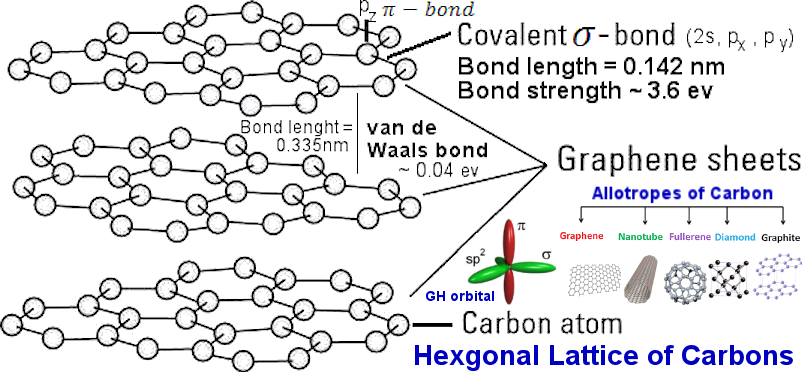
Fig. n 2
Nano Lett. 2015 Jan Epub 2014
Van der Waals force: a dominant factor for reactivity of graphene
Jong Hak Lee , Ahmet Avsar, Jeil Jung, Jun You Tan, K Watanabe, T Taniguchi, S. Natarajan, Goki Eda, Shaffique Adam, Antonio H Castro Neto, Barbaros Özyilmaz
DOI: 10.1021/nl5036012
“Reactivity control of the graphene is an important issue because chemical functionalization can modulate graphene's unique mechanical, optical, and electronic properties. Using systematic optical research studies, we demonstrate that van der Waals VDW interaction is the dominant factor for the chemical reactivity of graphene on 2-dimensional (2D) hetero- structures. A significant enhancement in the chemical stability of graphene is achieved by replacing the common SiO2 substrate with 2D crystals such as an additional graphene layer, WS2, MoS2, or h-BN. Our theoretical / experimental results show that its origin is a strong van der Waals VDW interaction between the graphene layer and the 2D substrate. This results in a high resistive force on the graphene toward geometric lattice deformation. We also demonstrate that the chemical- reactivity of the graphene can be controlled by the relative lattice orientation with respect to the substrates and thus can be used for a wide range of applications including hydrogen storage”
Self-assembly is a process- mechanims by which a disordered system of pre-existing components forms an organized structure or pattern like a consequence of specific, local interactions among the components themselves, without external direction.
When the constitutive components are molecules, the process is named molecular self-assembly.
Regarding the self-assembly process in nanoscience it is possible to see :

Fig. n 3 Conceptual scheme indicating the main stages of the self-assembly process in nanoscience. From doi: 10.3390/ma13051048
Related graphene materials:
Materials (Basel). 2020 Mar; 13(5): 1048.
2020 Feb 26. doi: 10.3390/ma13051048
Self-Assembly of Organic Nano materials and Bio materials: The Bottom-Up Approach for Functional Nanostructures Formation and Advanced Applications
Domenico Lombardo, Pietro Calandra, L. Pasqua, Salvatore Magazù
“Graphene self-assembly GSA represents a promising method also for micro electronic applications. Recently, graphene micro-patterns (consisting of crossed stripe of single- and 2-layer graphene) have been fabricated by means of the (evaporation-induced) self-assembly technique ”
Chinese Chemical Letters
Volume 29, Issue 6, June 2018, Pages 931-934
Chinese Chemical Letters
Communication
Self-assembly of graphene oxide GO nano-sheets in t-butanol/water medium under gamma-ray radiation
Weikang Wanga Yihu Wua Zhiwen Jianga Mozhen Wanga Qichao w. Xiao Zhoub Xuewu Gea
“The research on the properties of graphene oxide (G.O.) in various media has become one of the hottest topics since G.O is now the main raw material for graphene-based advanced materials. In this research work, the γ-ray radiation chemistry effect of GO nano-sheets and their self-aggregation behavior in t-butanol/water medium were investigated. The results show that G.O nano-sheets are reduced and hydroxy-alkylated simultaneously by alcohol free radicals produced by the radiolysis of t-butanol/water solution under γ-ray radiation. The radiation-modified G.O.nano-sheets will self-assemble into a self-standing graphene hydro gel when the pH of the solution is lower than 2. A hydroxyl-functionalized free-standing graphene aerogel is further obtained simply by freeze-drying. This work provides not only a general self-assembly SA mechanism of G.O. nano-sheets in strong acidic alcohol/water media under high energy radiation, but also a facile and economical preparation method for hydroxy-alkylated graphene-based aerogel.”

Fig. n 4
Understanding Self-assembly, Colloidal Behavior and Rheological Properties of Graphene Derivatives for High-performance Supercapacitor Fabrication
Xia-Wei Yun, Bo Tang, Zhi-Yuan Xiong ,Xiao-G. Wang
Chinese Journal of Polymer Science vol 38
“Graphene derivatives, as graphene oxide -(G.O.) and reduced graphene oxide (R.G.O.), have been widely used as promising 2-dimensional nano-scale building blocks due to their interesting properties, cost-effective production, and good processability. Understanding the intrinsic self-assembling, colloidal, and rheological features of the graphene derivatives is of critical importance to establish the formation-structure-property relationship of the graphene-based materials.”
Acta Biomaterialia
Volume 92, 1 July 2019
Graphene oxide containing self-assembling peptide hybrid hydrogels as a potential 3D injectable cell delivery platform for intervertebral disc repair applications
Cosimo Ligorio Mi Zhou Jacek K.Wychowaniec Xinyi Zhu Cia nBartlam Aline F.Miller Aravind Vijayaraghavanad Judith A.Hoyland A. Saiani
“In this reserach study we explore the use of graphene oxide (G.O.) as nano-filler for the reinforcement of FEFK.FEFK (β-sheet forming self-assembling peptide) hydrogels. Our results obtained confirm the presence of strong interactions between FEFK-FEFK and G.O. flakes with the peptide coating and forming short thin fibrils on the surface of the flakes. These strong interactions were found to affect the bulk properties of hybrid hydrogels. At pH 4 electrostatic interactions between peptide fibres and the peptide-coated G.O. flakes are thought to govern the final bulk- properties of the hydro-gels while at pH 7, after conditioning with cell culture media, electrostatic- interactions are removed leaving the hydro-phobic interactions to govern hydro gel final properties. The GO-F820 hybrid hydro gel, with mechanical properties similar to the NP, was shown to promote an high cell- viability and retained cell metabolic activity in 3D over the 7 days of culture and shown to harbour significant potential as an injectable- hydrogel scaffold for the in-vivo delivery of NP- cells.”
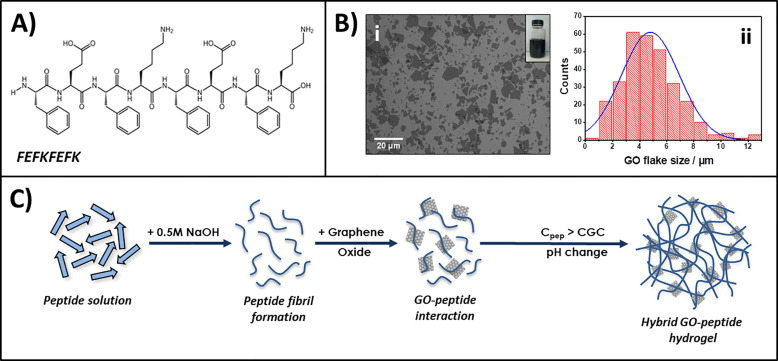
Fig. n 5 Chemical structure of FEFKFEFK peptide (A), SEM image of G.O. flakes (Bi) and flake size distribution (Bii). Bottom: Schematic representation of the formulation route used to prepare peptide/GO hybrid hydrogels (C).
Self-assembly can be classified as either static or dynamic. In static self-assembly, the ordered state forms as a system approaches equilibrium, reducing its free energy.In dynamic self-assembly, patterns of pre-existing components organized by specific local interactions are not commonly described as "self-assembled" by scientists in the associated disciplines. These structures are better described as "self-organized", although these terms are often used inter changeably.
Self-Assembly of Graphene Oxide at Interfaces
August 2014 Advanced Materials 26(32) DOI: 10.1002/adma.201400267
Jiao‐Jing Shao Wei Lv Wei Lv Quan‐H. Yang
“Due to its amphi philic property, graphene oxide (G.O.) can achieve a variety of nano structures with different morphologies (in ex. membranes, hydrogel, crumpled particles, hollow spheres, sack-cargo particles, Pickering emulsions) by self-assembly. The self-assembly is mostly derived from the self-concentration of G.O. sheets at various interfaces, including liquid-air, liquid-liquid , liquid-solid inter faces.”
Self-Assembled Magnetic Nan oparticle–Graphene Oxide Nanotag for Optomagnetic Detection of D.N.A.
Bo Tian, Yuanyuan Han, Jeppe Fock, Mattias Strömberg, K. Leifer, Mikkel Fougt Hansen
ACS Appl. Nano Mater. 2019 March 5 https://doi.org/10.1021/acsanm.9b00127
“In this work, a 2-dimensional self-assembled magnetic nanoparticle–graphene oxide (MNP-GO) nano composite is reported for the detection of D.N.A.. Single-stranded D.N.A. (ssD.N.A.) coils, generated through a rolling -circle amplification (RCA) reaction triggered by the hybridization of target oligos and padlock probes, have a strong interaction with MNP-G.O nano-tags through several mechanisms including π–π stacking, hydrogen bonding, van der Waals VDW , electrostatic, and hydro phobic interactions. This interaction leads to a hydro dynamic size increase or aggregation of MNP-G.O. nano tags, which can be detected by a simple opto magnetic setup. Due to the high shape anisotropy, MNP-G.O nano-tags provide stronger opto-magnetic signal than individual MNPs. The avoidance of D.N.A. probes (short ssD.N.A. sequences as the bio-sensing receptor) provides easier material preparation and lower measurement cost.
From real-time measurements of interactions between MNP-GO and RCA products amplified from a highly conserved Escheric. coli 16S rD.N.A. sequence, a limit of detection of 2 pM was achieved with a total assay time of 90 min. Although the non-specific binding force between G.O. and ssD.N.A. is much weaker than the specific base-pairing force in a D.N.A. duplex, the proposed method provides a detection limit similar to D.N.A. probe-based magnetic bio-sensors, which can be ascribed to the abundant binding sites between G.O. and ssD.N.A.. For target concentrations higher than 100 pM, the MNP-G.O nano tags can be applied for a qualitative naked eye detection strategy based on nanotag–ssD.N.A. flocculation”
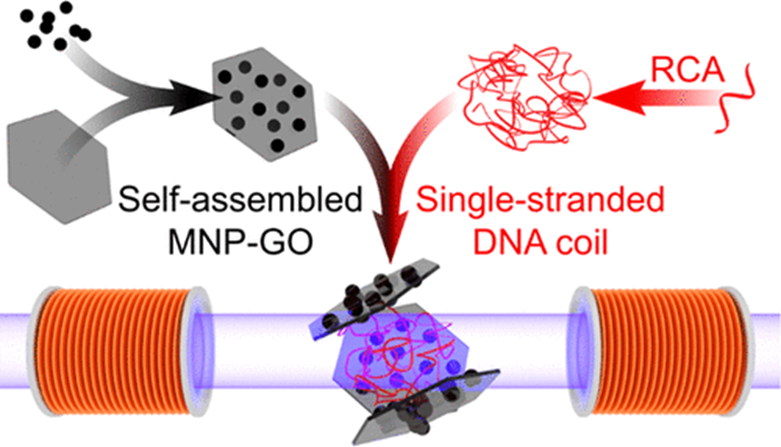
Fig. n . 6
Whit an observational point of view various relevant literature and figure are reported and analysed.
After this reviw part an experimental project hypotesys will be submitted to researcher in order to produce a global conclusion related the topics of this wors
All literature comes from bio medical or other scientific or technological involved database .
RESULTS
Carbon
Volume 158, March 2020
Review article
Graphene oxide in aqueous and nonaqueous media: Dispersion behaviour and solution chemistry
Wencheng Duab et al
https://doi.org/10.1016/j.carbon.2019.11.027
“Graphene oxide (G.O.) is a unique 2-dimensional (2D) material with interesting physical/chemical properties. GO can be considered as a 2D amphiphilic conjugated polymer, consisting of hydro-philic oxygenated groups and hydro phobic conjugated graphitic- domains. The diverse chemical groups endow GO with high chemical activity to react with other molecules and form new species with graphitic framework. the amphiphilic properties of G.O. sheets provide them the abilities to self-assemble into 3-dimensional (3D) structure or reduced G.O (rGO) gels with porous micro-structures. The precondition of these promising properties of G.O. is its excellent solution-like dispersibility in aqueous or non-aqueous media. These liquid media facilitate the exfoliation of G..O into single-layer sheets and provide the exfoliated G.O sheets with specific chemical environment for functionalization and/or processing. It is essential to understand the solution-based chemical behaviour of G.O, which is important for better application of the G. O. In this review work , we outline the solution-based chemistry of GO mainly in terms of molecular structure, dispersibility in solvents, solution properties and related processing of GO sheets. This review work aims to systematically present physical/chemical behaviours of G.O in solvents including aqueous and non aqueous solvents, which is helpful for better understanding and application of G.O. materials.”(1)
Disordered protein-graphene oxide co-assembly and supramolecular biofabrication of functional fluidic devices
Yuanhao Wu, Babatunde O. Okesola, Jing Xu, Ivan Korotkin, Alice Berardo, Ilaria Corridori, Francesco Luigi Pellerej di Brocchetti, J. Kanczler, Jingyu Feng, Weiqi Li, Yejiao Shi, Vladimir Farafonov, Yiqiang Wang, Rebecca F. Thompson, Maria-M. Titirici, D. Nerukh, Sergey Karabasov, Richard O. C. Oreffo, Jose Carlos Rodriguez-Cabello, Giovanni Vozzi, Helena S. Azevedo, N. M. Pugno, Wen Wang , Alvaro Mata
Nature Communications volume 11
Co-assembly
“We used G.O sheets of 2 different average lateral sizes, including larger G.O. (GO-L) measuring 10.5 ± 4.5 µm and smaller G.O. (GO-S) of 2.3 ± 0.9 µm, both exhibiting a typical hydro phobic- surface and negatively charged carboxylic- groups on their periphery (. We chose ELRs as the protein component because of their modular and disordered nature and the possibility to exhibit different molecular conformations at the different temperatures. The ELK1 sequence is a 51.9 kDa molecule consisting of 24 repeats of a single block made of four hydro-phobic penta peptides (VPGIG) and a positively(+) charged (VPGKG) one. This relatively simple molecular design offers an accessible transition temperature (Tt) of 30 °C (at 2% ELK1 in MilliQ water) with clearly different ELR conformations above or below it, as well as medium molecular -weight to enable both cooperative interactions between its charged and hydro-phobic segments as well as with the anionic edge and hydro phobic surface of the G.O . ELRs with similar molecular weight but different levels of charge and hydro -phobicity , as well as a single repeat of an individual block of each of these three ELRs, were used as controls .
Fig reported 1: Molecular building blocks and rationale for When an ELK1 solution at its Tt (30 °C) is immersed in a larger volume of a G.O .solution, a multilayered membrane of up to 50 µm in thickness develops at the interface around the immersed drop maintaining both solutions separated . This membrane consists of layers made from both G.O. sheets and ELK1 , with G.O sheets being present throughout the cross-section of the membrane and ELK1 gradually decreasing in concentration from the inside (ELK1- side) to the outside (G.O side) of the membrane . Multi-layered structures are known to emerge from diffusion–reaction mechanisms. We have previously demonstrated that co-assembling PAs with ELRs, it is possible to trigger a diffusion–reaction mechanism, which generates multi-layered membranes capable of exhibiting dynamic- properties. In Similar way, by touching any surface within the first few seconds of formation, the ELK1–G.O. membrane adheres, spontaneously and reproducibly opens, and can be manipulated to grow into a tubular structures with spatio-temporal control .In this case, the underlying ELR-G.O mechanism of interaction and supra molecular assembly lead to the growth of a material with remarkably enhanced properties”. (2)
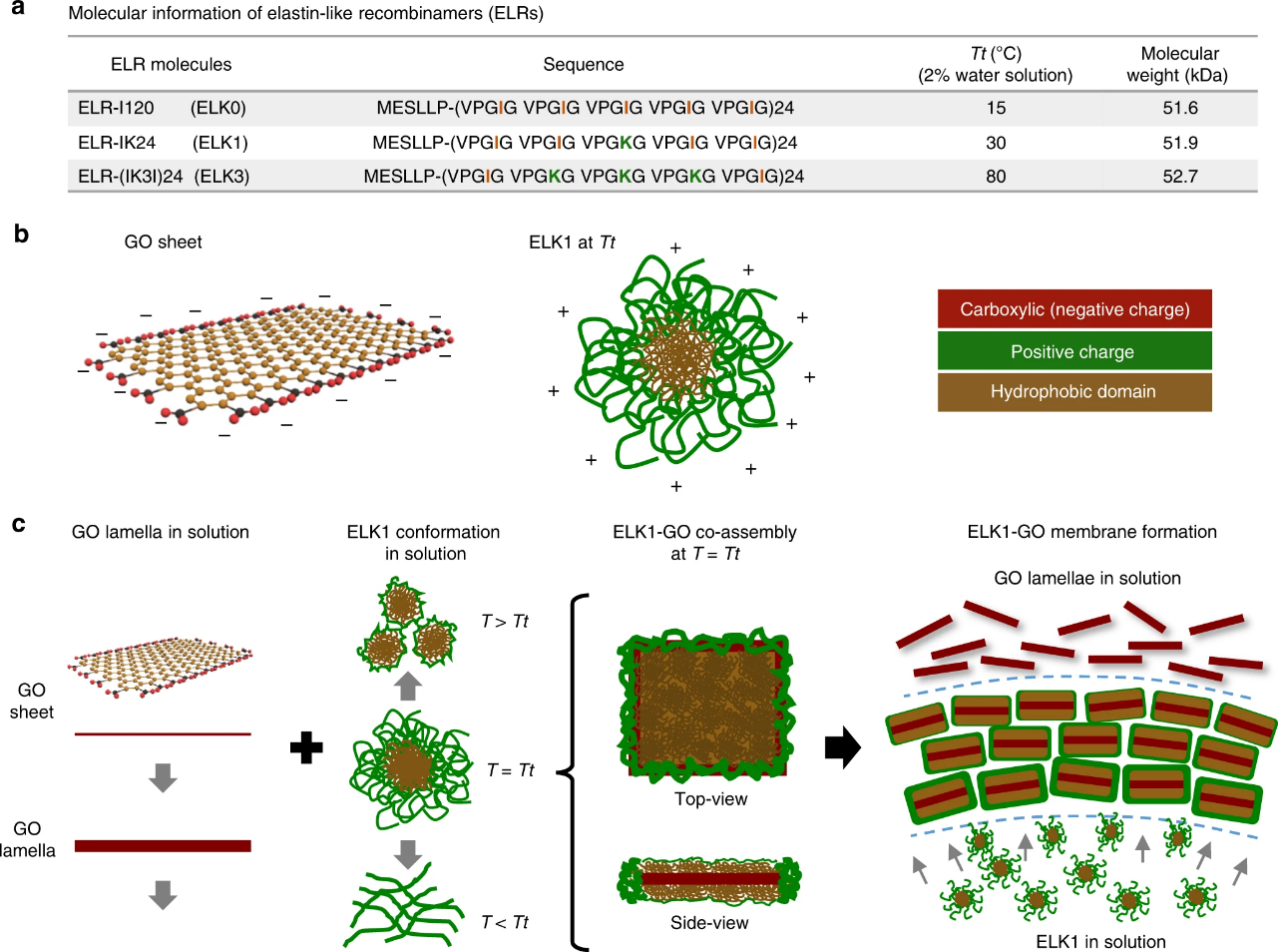
Fig. n 7 table summarizes the key information of the three elastin-like recombinamers (ELRs) used in the study comprising similar molecular weight but different levels of hydro-phobicity (VPGIG) and positive charge (VPGKG). b Illustrations of the molecular -structure of a G.O sheet and the supra-molecular organization of ELK1 at its transition temperature (Tt) (30 °C) indicating both the charged (red and green) and hydro phobic (brown) segments. c Schematic of the proposed mechanism of formation illustrating the molecular and supra-molecular conformation of the G.O and ELK1 before and after the co-assembly at the ELK1’s Tt as well as their interaction for membrane formation.
Toxicity studies of six types of carbon nano particles in a chicken-embryo model
april 2017 international journal of nanomedicine
“ In the present research study, the toxicity of six different types of carbon nano particles (CNPs)
was investigated using a chicken-embryo model. Fertilized chicken eggs were divided into this
following treatment groups: placebo, diamond- NPs, graphite NPs, pristine graphene, small
graphene oxide, large graphene oxide GO, and reduced graphene oxide.
Self-assembly of CNPs with albumin amino- acids by non-covalent bonds is very efficient, implying
that CNPs can be effectively transported into embryos. According to Szmidt et al, lower concentrations(50 and 500 μg/mL) of graphene penetrate the embryo more
efficiently than higher concentrations, due to different NP- dispersion levels. These results were explained by the natural tendency of CNPs to agglomerate when they are coated by the albumin proteins that surround the embryo.In the present RESEARCH study work , we also administrated CNPs to the egg albumin, which
gets progressively consumed by the embryo during the development process and is ultimately fully absorbed, ensuring that the whole dose was delivered during the embryo-genesis. “(3)
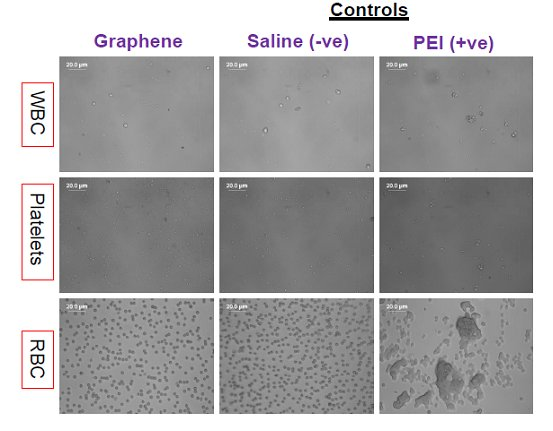
Fig. n 8 Blood cell aggregation on incubation of graphene with blood from Blood Compatibility and Bio medical Applications of Graphene
August 2011Trends in Biomaterials and Artificial Organs 25:91-94
Willi PaulWilli PaulChandra P SharmaChandra P Sharma
DOI: 10.1039/C8NH00318A (Review Article) Nanoscale Horiz., 2019, 4, 273-290
Graphene oxide touches blood: in vivo interactions of bio-coronated 2D materials
V. Palmieri , G. Perini , M. De Spirito , M. Papi
Received 21st September 2018 , Accepted 17th October 2018
“In the blood, non-covalent adsorption occurs through weak van der Waals VDW forces, hydro phobic, electrostatic, and π–π stacking interactions. The sp2 hybridized honey-comb carbon- lattice of rGO and G.O. is hydrophobic and, interacts with the hydrophobic -regions of proteins, according to the protein geometry. The basal plane of the G.O is also enriched with π electrons, making π–π stacking interactions possible. At the same time the oxygen -groups of G.O., whose composition is strictly dependent on preparation and storing conditions, allow further hydrogen- bonds and electrostatic bonds. These electrostatic- bonds are strongly influenced by the charge on the proteins and by pH and ionic strength of the buffer. Bonding on G.O. can also be mediated by van der Waals- interactions. While the electrostatic- interactions are more pronounced on G.O, both van der Waals WdW and electrostatic -interactions play a major role in the adsorption of proteins on Rg.O due to the increase in the non-functionalized area on the surface. In the following sections, we will show how functionalization of the G.O. surface alters protein adsorption and consequently BC -properties” .
Effects of bio-coronated G.O materials on blood components
BC composition directly influences interactions with other blood components . The presence of antibodies, complement and clotting factors in the nano particle BC may activate clotting and coagulation cascades. The BC coating can promote phagocytosis and elimination from circulation.
We will first consider data on the G.O. interaction with the red blood cells , in Table reported. An intravenously IV injected nanomaterial is likely to interact first with R.B.Cs rather than other cells, due to their abundance in blood. Hemolysis represents the damage to RBCs that leads to the leakage of hemoglobin into the blood-stream. After hemolysis, the nano-material may adsorb released hemoglobin and/or adhere to cell debris, which can increase its likelihood of elimination by macro-phages. Although the literature is contradictory regarding G.O. effects on R.B.C., when BC is introduced into the framework the results become clearer. Due to the sharp edges of G.O. and Rg.O, hemolytic- effects might be expected in vivo, possibly caused by nano-material blades disrupting cell- membranes, as reported for G.O interactions with bacteria.“ (4)

Fig. n 9 Main results of G.O interaction with the blood components are summarized in this illustration of the injection of GO flakes in the blood-stream. The formation of the BC (1) prevents the hemolysis of red blood cells (2a). Thrombosis (2b) and interaction with the complement -proteins (2c) are ascribed to GO. In (2d) some of the possible fates after macro-phage encounters are shown: extra-cellular blocking or intra-cellular uptake. The release of cytokines occurs when macro-phages uptake GO. Aggregates of G.O. in macro-phage cytoplasm induce the production of pro-inflammatory cytokines. Dendritic -cells fail to present antigens to lymphocytes when they uptake G.O (2e). Lymphocyte activity is not inhibited, and BC protects lymphocytes from apoptosis (2f). from DOI: 10.1039/C8NH00318A
Int J Mol Sci. 2019 Jan
Differential Immuno modulatory Effect of Graphene Oxide and Vanillin-Functionalized Graphene Oxide Nano particles in Human Acute Monocytic Leukemia Cell Line (THP-1)
Sangiliyandi Gurunathan , Min-Hee Kang , M. Jeyaraj , Jin-Hoi Kim
“Graphene and its derivatives are emerging as attractive and interesting materials for the bio medical applications, including anti-bacterial, the gene delivery, contrast imaging, and anticancer therapy applications. It is of fundamental importance to study the cyto-toxicity and bio compatibility of these materials as well as how they interact with immune -system.
The present research study was conducted to assess the immuno-toxicity of graphene oxide (G.O.) and vanillin-functionalized G.O (V-rGO) on THP-1 cells, a human acute monocytic leukemia cell line. The synthesized G.O and V-rGO were characterized by using various analytical techniques. Various concentrations of G.O and V-rGO showed toxic effects on THP-1 cells such as the loss of cell viability and proliferation in a dose-dependent manner. Cyto-toxicity was further demonstrated as an increased level of lactate dehydrogenase (LDH), loss of mitochondrial membrane -potential (MMP), decreased level of ATP content, and cell death. Increased levels of reactive oxygen species and lipid -peroxidation caused redox imbalance in THP-1 cells, leading to increased levels of malon-dialdehyde and decreased levels of anti-oxidants such as glutathione , glutathione- peroxidase , super oxide dismutase , and catalase . Increased generation of ROS and reduced MMP with simultaneous increases in the expression of pro-apoptotic genes and downregulation of anti-apoptotic genes suggest that the mitochondria-mediated pathway is involved in G.O and V-rGO-induced apoptosis. Apoptosis was induced consistently with the significant D.N.A. damage caused by increased levels of 8-oxo-dG and upregulation of various key D.N.A.-regulating genes in THP-1 cells, indicating that G.O. and V-rG.O induce cell death through oxidative stress. As a result of these events, G.O and V-rGO stimulated the secretion of various cytokines and chemokines, indicating that the graphene materials induced potent inflammatory responses to THP-1 cells. The harshness of V-rGO in all assays tested occurred because of better charge transfer, various carbon to oxygen ratios, and chemical compositions in the rG.O. Overall, these research findings suggest that it is essential to better understand the parameters governing G.O. and functionalized G.O. in immuno- toxicity and inflammation. Rational design of safe G.O-based formulations for various applications, including nanomedicine, may result in the development of risk -management methods for people exposed to graphene and graphene family materials, as these nano particles can be used as delivery agents in various bio medical applications.”(6)
ACS Nano . 2020 Jan
Graphene Oxide Promotes Cancer Metastasis through Associating with Plasma Membrane To Promote TGF-β Signaling-Dependent Epithelial-Mesenchymal Transition
Jianqiang Zhu , Bin Li , M. Xu , Rui Liu , Tian Xia , Zhihong Zhang , Yong Xu , Sijin Liu
“Nano medicines are being developed to treat diverse diseases; inadvertent or un-intended health effects have to be considered, especially for those targeting cancers. For the cancers, occurrence of metastasis hints an advanced phase of the cancer progression, and nano medicines per se should be evaluated for their effects on existing metastatic tumors and triggering metastases.
Graphene-based 2D nano- materials, such as graphene oxide (G.O.), due to its unique characteristics, have been extensively studied for bio medical applications including cancer therapy. the potential effect of G.O on metastasis has not been determined yet. We found that low-dose G.O could induce significant morphological and structural changes of the cellular membrane within cancer cells, suggesting an epithelial-mesenchymal transition , with enhanced invasion/migration
and the alterations of representative EMT indicators in G.O-treated cells. These changes resulted in enhanced lung -metastasis of cancer cells in various metastasis models.
The mechanistic investigations unveiled that G.O increased the protein levels of the TGF-β receptor, leading to a constitutively activated TGF-β-Smad2/3 signaling path-way that drives the EMT. Our findings enhance the understanding of the un-intended side and detrimental effects of G.O. nano-sheets in increasing the progression of metastatic- tumors. Thus, the likeli-hood of pro-EMT effects upon low-dose GO exposure should be considered when developing G.O. nano medicines.” (7)
Part Fibre Toxicol.
2016 Oct
Toxicity of graphene-family nano particles: a general review of the origins and mechanisms
Lingling Ou,Bin Song, Huimin Liang, Jia Liu, Xiaoli Feng, B. Deng, Ting Sun, Longquan Shao
“A high dose of G.O. that forms aggregations can block the pulmonary blood -vessels and result in dyspnea , and platelet thrombi were observed at high concentrations of 1 and 2 mg/kg body weight via intravenous IV injection” . (8)
Interaction of Graphene Oxide GO with Proteins and Applications of their Conjugates
March 8, 2017
Simsikova M, Sikola T (2017) Interaction of Graphene Oxide with Proteins and Applications of their Conjugates. J Nanomed Res 5(2)
“Graphene oxide (G.O.) has abundant surface oxygen-containing groups such as epoxide, hydroxyl, and carboxylic - groups; it can be prepared through the oxidative intercalation and exfoliation of graphite on a mass scale. Owing to the enriched surface functionalities, the G.O is water-soluble and chemically versatile. The surface functional -groups can also provide plenty of reaction sites for linking the nano particles, proteins, enzymes, peptides, bacteria, cells, nucleic acids through covalent and non-covalent binding.
G.O has been used as a matrix for protein immobilization in different bio technological applications such as fluorescence- or electrochemical-based sensors, labeling and imaging, therapy, and targeted delivery. Non Covalent - interaction (Physical -adsorption)
Non-covalent protein adsorption onto solid supports represents the most simple and desirable strategy of physical immobilization. The mechanisms of proteins adsorption on G. O is a kind of non-covalent self-assembly including weak Van der Waals VDW forces, hydro phobic, electrostatic, and π-π stacking interaction. These types of attractions between proteins and graphene oxide G.O. involve solution phase incubation, or direct sonication, followed by a washing step to remove the un-bound proteins. The non-covalent bonds responsible for the interaction between G.O and proteins vary depending on the surface properties of graphene oxide, such as morphology and hydro-phobicity.” (9)
Journal of material research
Understanding the hemotoxicity of graphene nanomaterials through their interactions with blood proteins and cells
Cambridge University Press: 06 November 2017
Journal of Materials Research , Volume 33 , Issue 1: Annual Issue: Early Career Scholars in Materials Science 2018
“Although information on the in vitro and in vivo nano toxicity of graphene nano materials has been increasingly published in the last several years, a complete picture on the biocompatibility of graphene nano-materials has not been established.
the successful applications of graphene nano-materials in nano bio-technology and medicine as well as their effective translation into real clinical utility hinge significantly on a thorough understanding of their nano toxicological profile. Of all aspects of bio compatibility, the hemo-compatibility of graphene nano materials with different blood constituents in circulatory system is one of the most important elements that needs to be well elucidated. Once administered into biological systems, graphene nanomaterials may inevitably come into contact with the surrounding plasma proteins PP and blood -cells. Crucially, the interactions between these hematological entities and graphene nano-materials will influence the overall efficacy of their bio medical applications. As such, a comprehensive understanding of hemo toxicity of graphene nanomaterials is critically important. he in vitro evaluations of the potential cytotoxic effects of graphene nano materials have been actively conducted on different human cell -lines, such as human fibroblasts, human umbilical vein endothelial -cells , normal human lung -cells (BEAS-2B), human lung cancer cells (A549), human hepato carcinoma cells , HeLa cells, and human breast cancer cells MCF-7. A majority of these investigations have demonstrated the time- and dose-dependent cytotoxicity of graphene nanomaterials. Numerous in vitro experimental and theoric investigations have attributed the cyto toxicity of both graphene and its oxygenated derivative G.O. on the mammalian cells and bacteria to cellular membrane penetration, followed by phospho--lipid molecule extraction from the lipid -bilayer.
G.O. has been demonstrated to possess a high loading capacity for albumin and fibrinogen in a recent work. Reference Kenry, Loh and Lim. While numerous studies have reported observations on graphene nano material-induced protein conformational change, the under-lying mechanisms are still poorly understood G.O. have a surface area of 25 nm2 and randomly decorated hydroxyl and epoxy- groups on its surface. A carboxyl group was attached to the G.O edges. While having the same surface area, in comparison to G.O, the rGO model possesses fewer oxygenated functional groups. G.O nano-sheets have been reported to possess a strong thrombus-inducing potential and considerable thrombo- genecity. They could trigger the activation of platelets PTL and their strong aggregatory response similar to that evoked by thrombin, an active physiological platelet agonist. The platelet activation by G.O .was suggested to be extensively dependent on the surface charge distribution of G.O. as it was revealed that, in contrast to G.O, rGO with reduced surface charge density was less capable in activating and aggregating platelets PTL. The pro-thrombotic characteristic of GO nano-sheets was further verified through the occurrence of significant pulmonary thrombo embolism after their intravenous IV administration in mice.”(21)
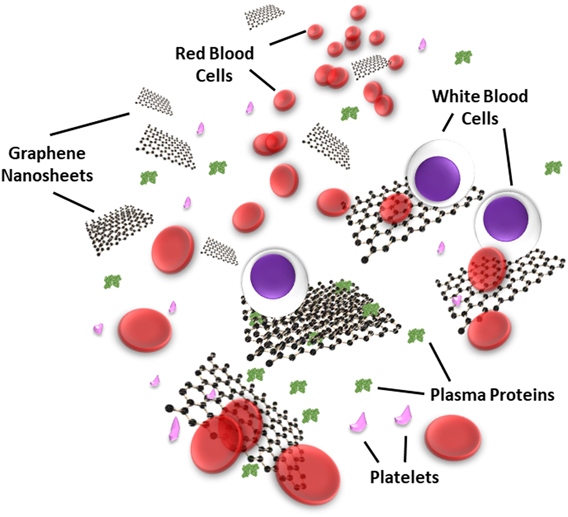
Fig n . 10 Nano-bio interactions of graphene nanomaterials with various blood plasma proteins and cells.
Chem Soc Rev. 2015 Oct
Interfacing proteins with graphitic nanomaterials: from spontaneous attraction to tailored assemblies
Federica De Leo , A. Magistrato, Davide Bonifazi
“This critical review work aims at giving insights on the spontaneous tendency of the proteins and their constitutive parts to adsorb on graphitic nano-materials (GNM s) through non-covalent interactions occurring at their in their interfaces “(22)
Toxicity of graphene-family nano particles:
a general review of the origins and mechanisms
Lingling Ou , Bin Song , H. Liang, Jia Liu , Xiaoli Feng , Bin Deng , T. Sun and Longquan Shao
“This review work collects studies on the toxic effects of GFNs in several organs and cell models. We also point out that various factors determine the toxicity of GFNs including lateral size, surface structure, functionalization, charge, impurities, aggregations, corona effect . Several typical mechanisms underlying GFN toxicity have been revealed, for instance, physical destruction, oxidative stress, D.N.A. damage, inflammatory response, apoptosis, autophagy, and necrosis. In these kind of mechanisms, (toll-like receptors-) TLR-, TGF-β-and TNF-α dependent-pathways are involved in the signalling pathway network, and oxidative stress plays a crucial role in these pathways” (22)
Singh ZS. Applications and toxicity of graphene family nanomaterials and their composites. Nanotechnol Sci Appl. 2016;9:15-28
https://doi.org/10.2147/NSA.S101818
“Toxicity of graphene family nano particles
The dose, shape, surface- chemistry, exposure route, and purity play important roles in differential toxicity of GFNs. Different authors have used various toxicity tests to evaluate the toxicity of GFNs. Studies have been conducted to find out the toxicity of GFNs on different cellular and animal- models, including stem cells, HeLa cells,HepG2 cells,bacteria, Drosophila melanogaster, Zebra-fish, marine organisms,rats, mice, and the mammalian cells. Cytotoxicity tests indicated that the Rg.O can damage cells with direct contact. In this part of the paper, an attempt has been made to compile the recent and up-to-date research studies related to toxicological aspects of GFNs to different models. (23)”
Vol. 106 No. 8 (2021): August, 2021
Post-mortem findings in vaccine-induced thrombotic…
CASE REPORTS
Post-mortem findings in vaccine-induced thrombotic thombocytopenia
Cristoforo Pomara Francesco Sessa Marcello Ciaccio Francesco Dieli Massimiliano Esposito Sebastiano Fabio Garozzo Antonino Giarratano D.Prati Francesca Rappa M. Salerno Claudio Tripodo Paolo Zamboni Pier M. Mannucci
Vol. 106 No. 8 (2021): August, 2021 https://doi.org/10.3324/haematol.2021.279075
“The peculiar features of these cases were the availability of macroscopic and micro-scopic autopsy findings. The main macro-scopic finding was that venous- thrombosis was much more wides-pread and catastrophic than diagnosed by imaging during life. Microscopic findings showed vascular thrombotic occlusions occurring in the micro-circulation of multiple organs and increased inflammatory -infiltrates.”(24)
Int J Legal Med. 2021; 2021 Sep 30. doi: 10.1007/s00414-021-02706-9
Postmortem investigation of fatalities following vaccination with COVID-19 vaccines
Julia Schneider, Lukas Sottmann, A. Greinacher, Maximilian Hagen,Hans-Udo Kasper, Cornelius Kuhnen, Stefanie Schlepper,Sven Schmidt, R. Schulz, Thomas Thiele, Christian Thomas,Andreas Schmeling
“Postmortem investigations of fatalities after COVID-19 vaccination are particularly relevant with regard to the detection of anaphylaxis, VITT, and myocarditis
Vaccine-induced immune thrombotic thrombo-cytopenia (VITT)
VITT is characterized by thrombo-cytopenia, combined with thrombosis in most cases. Thrombosis can occur in the both arterial and, more common, venous system. A distinctive feature of VITT is thrombosis in unusual locations. These include CVT, as well as splanchnic- venous thrombosis ”. (25)
Applied Materials Today
Volume 12, September 2018,
Investigation into the toxic effects of graphene nanopores on lung cancer cells and biological tissues
T. A.Tabisha et al
“In this research work, for the first time, we studied the in vitro and in vivo interactions of a relatively new derivative of graphene, graphene -nanopores (G.N.Ps) in mammalian systems, to systematically elucidate the possible mechanism of their toxicity over time. Heart tissue showed chemo-dectoma, toxic myocarditis, reddish brown atrophy; yellowish brown pigments suggesting lipofuscin- granules as remnants of cell organelles and cytoplasmic- material”. (26)
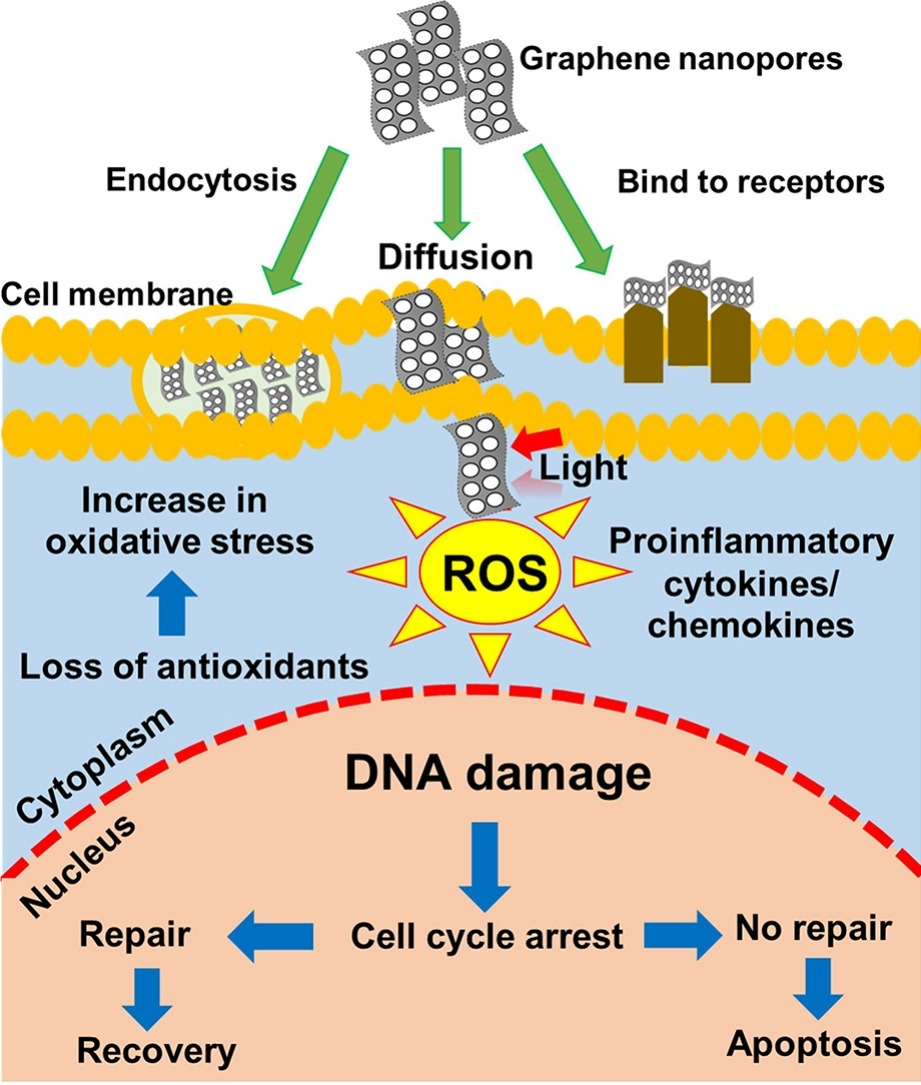
Fig. n 11
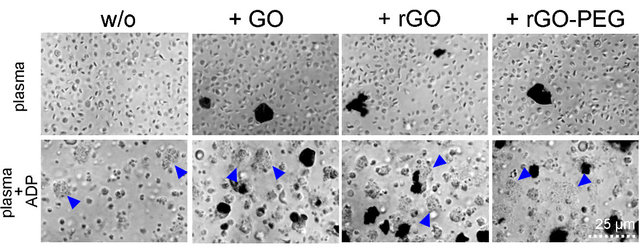
Fig. n 12 The effect of G.O, rGO, and rGO-PEG on the platelet activation: Graphene nanoderivatives were co-incubated with platelet rich plasma at 50 µg/mL. Platelet activation was induced by the addition of 2 µmol/mL of adenosine diphosphate (ADP). The Platelet PTL aggregates are pointed by the blue arrows. One representative picture reflects the results of three independent experiments. G.O; rGO reduced graphene oxide; rGO-PEG, PEGylated reduced graphene oxide; ADP, adenosine -diphosphate.
From DOI: 10.3390/cells9030776

Fig. n 13 from https://www.cd-bioparticles.com/t/Properties-and-Applications-of-Carbon-Nano particles_61.htmz
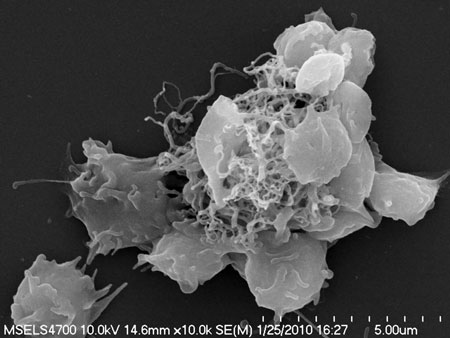
Fig n 14 Scanning electron microscopy image shows platelet activation by multiwallled CNTs (M60). Platelets were incubated with 100 µg/mL of M60 at 37°C for 15 minutes under gentle agitation. The images are representative of at least three individual experiments with platelets PTL from different donors. (Image: Jan Simak, FDA)
Food Chem Toxicol . 2016 . doi: 10.1016/j.fct.2016.09.034. Epub 2016 Oct 1.
Hemorheological characteristics of red blood cells exposed to surface functionalized graphene quantum dots
Jeongho Kim et al
DOI: 10.1016/j.fct.2016.09.034
“R.B.Cs were exposed to 3 different forms of G.Q.Ds (non-functionalized, hydroxylated, and carboxylated GQDs) at various concentrations (0, 500, 750, and 1000 μg/mL) and incubation times (0, 1, 2, 3, or 4 h). The rheological characteristics of the RBCs were measured using micro fluidic-laser diffractometry and aggregometry. The hemolysis rate and rheological -alterations of the RBCs were insignificant at a concentration less than 500 μg/mL. Carboxylated -GQDs were observed to have more substantial hemolytic activity and caused abrupt changes in deformability and aggregation of the RBCs than the non-functionalized or hydroxylated- G.Q.Ds at concentrations >750 μg/mL. Our findings indicate that hemo rheological assessments could be utilized to estimate the degree of toxicity to cells and to obtain useful information on safety sheets for nano -materials.” (27)
EXPERIMENTAL PROJECT HYPOTESYS
In order to verify in vitro the self- assembling property of graphene GO it is necessary to test
100 human blood speciman with added graphene GO ac concentration similar to as reported in literature
100 human blood specimen with no added ( controll group)
All this sample must to be sended to various certified and indepened analytical laboratory and tested using blind.
If possible send some sample also at various university centre.
With various methods ( microscopic cytology, darkfield microscope analisys, RAMAN destructive methods, microsocpe raman et other useful ).
Results : the reuslt must be reported in a table in two column
Object of the search : slef -aggreates of graphene
Time of observation : T 1H after collecting sample and added graphene , at 4 H, after 24 H , the after 1- week( needed to use anticoagulant that non produce interference wirh graphene GO )
At time after 1h after the graphene addition coagulative test must to be performed ( DD , fibrinogen and other as well as emocromocitometric assay. ( plateled, RBC, mircospope assay )
RESULTS : to verify if there is difference between the group a and b in significative way p < 0,005
DISCUSSION
In the literature reported it is clear the self-assembling properties of graphene detivates as well as clear is the effect that this products and aggregate produce on blood .
The same it is clear by scientific literature the pro-coagulant effect of spike protein during the pathological process in covid-19 disease.
Because there an nowadays debate about the presence or absence of graphene derivates in some vials of covid- 19 new vaccine it is crucial to think at what can happen when this 2 toxic molecule act in the same moment ( spike protein and graphene – aggregates )in an human body.
Because many biotechnological process in last decades see the introduction of innovative material like graphene derivates this molecule must to be analitycally escluded for release of biopharmaceuticals and so for the covid-19 vaccine.
Thombosys effect can be increase when 2 differenst stimucly actin simultaney way like a
Synergic effect.
And what can be the global effect in an unbalanced blood system like VITT ?
The clinical effect of this poisonus association must to be deeply more investigated for publich safety need.
CONCLUSION
Because in toxicology are well knowed various situation of combined toxic effect by multiple chemical dangerous exposure It is needed to verify the clinical effect of the self-assembling graphene GO effect added to spike protein using In vitro sample ( Animal model – and sample from humans specimens : subjects volunteers).
The experimental project submitted can help for this scope.
It is also of interest to verify if the cumulative effect of this two substatia Graphene GO and SPIKE protein
Show and added toxic effect (sinergic) or this is greter then the single molecule acting alone
And the kinetic related.
(This project must to be conducted under all stricly etichal comitee criteria) .
CONFLIC OF INTEREST : NO
Etichal consideration : all international rules are respected.